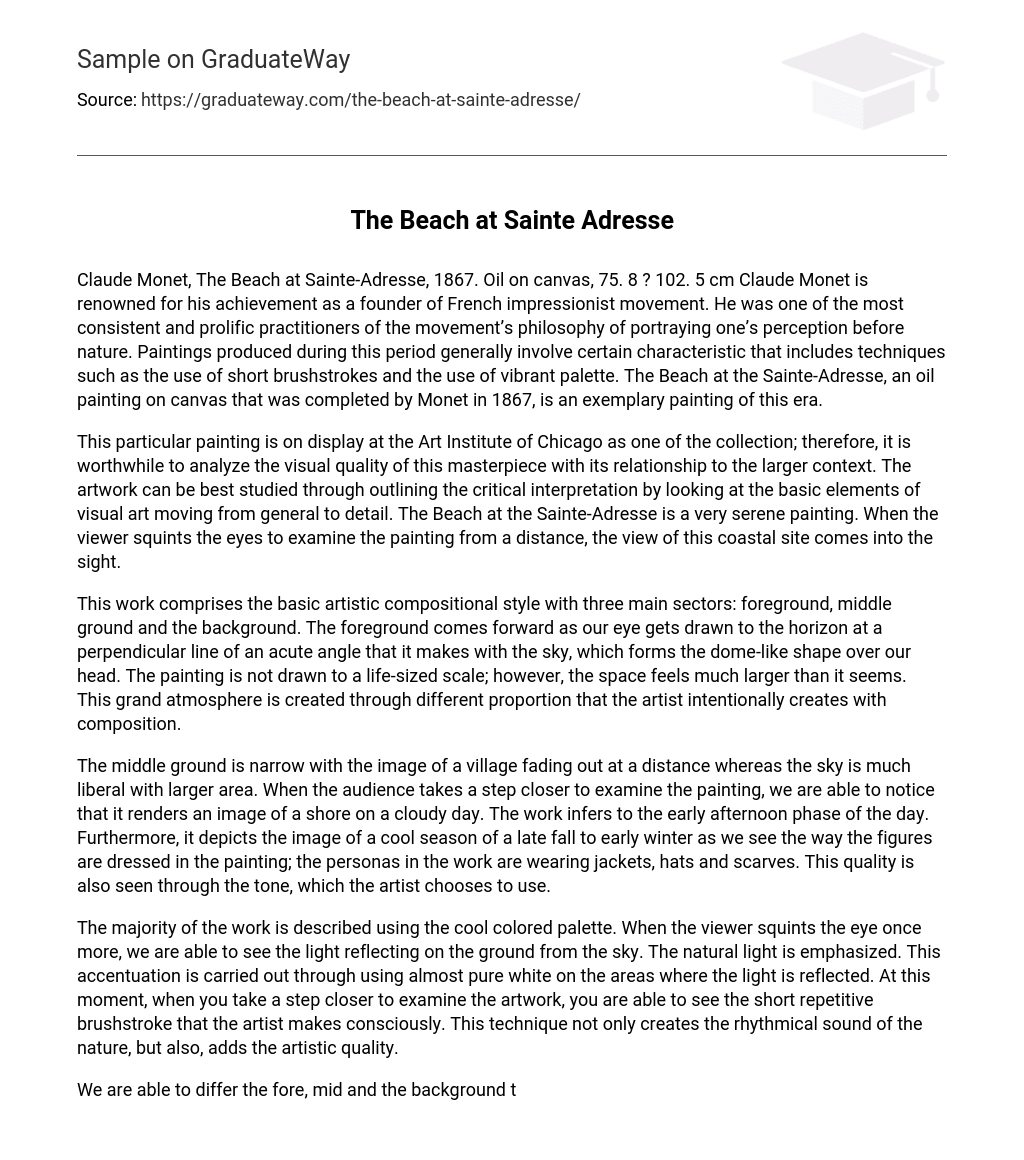Claude Monet, The Beach at Sainte-Adresse, 1867. Oil on canvas, 75. 8 ? 102. 5 cm Claude Monet is renowned for his achievement as a founder of French impressionist movement. He was one of the most consistent and prolific practitioners of the movement’s philosophy of portraying one’s perception before nature. Paintings produced during this period generally involve certain characteristic that includes techniques such as the use of short brushstrokes and the use of vibrant palette. The Beach at the Sainte-Adresse, an oil painting on canvas that was completed by Monet in 1867, is an exemplary painting of this era.
This particular painting is on display at the Art Institute of Chicago as one of the collection; therefore, it is worthwhile to analyze the visual quality of this masterpiece with its relationship to the larger context. The artwork can be best studied through outlining the critical interpretation by looking at the basic elements of visual art moving from general to detail. The Beach at the Sainte-Adresse is a very serene painting. When the viewer squints the eyes to examine the painting from a distance, the view of this coastal site comes into the sight.
This work comprises the basic artistic compositional style with three main sectors: foreground, middle ground and the background. The foreground comes forward as our eye gets drawn to the horizon at a perpendicular line of an acute angle that it makes with the sky, which forms the dome-like shape over our head. The painting is not drawn to a life-sized scale; however, the space feels much larger than it seems. This grand atmosphere is created through different proportion that the artist intentionally creates with composition.
The middle ground is narrow with the image of a village fading out at a distance whereas the sky is much liberal with larger area. When the audience takes a step closer to examine the painting, we are able to notice that it renders an image of a shore on a cloudy day. The work infers to the early afternoon phase of the day. Furthermore, it depicts the image of a cool season of a late fall to early winter as we see the way the figures are dressed in the painting; the personas in the work are wearing jackets, hats and scarves. This quality is also seen through the tone, which the artist chooses to use.
The majority of the work is described using the cool colored palette. When the viewer squints the eye once more, we are able to see the light reflecting on the ground from the sky. The natural light is emphasized. This accentuation is carried out through using almost pure white on the areas where the light is reflected. At this moment, when you take a step closer to examine the artwork, you are able to see the short repetitive brushstroke that the artist makes consciously. This technique not only creates the rhythmical sound of the nature, but also, adds the artistic quality.
We are able to differ the fore, mid and the background through differentiating the types of brushstroke. The middle ground has very subtle marks depicting the shadow; the technique of applying the brushstroke in the foreground is very detailed with shorter marks whereas the weight of the brushstroke is much thicker in the background with less detail. In the shadowed regions, no pure black is used. Instead, dark shades of blues are used to show the reflected light of the sky. This technique shows that the painting was completed while being outside. The statement that this is a very serene painting can be re-emphasized once more.
The horizon line forms a straight horizontal plane creating the soothing atmosphere; the tide of the water is calm. Moreover, looking at the figures in the frame extends the soothing mood where they all seem peaceful and relaxed. When you take a step closer to the painting, you can scrutiny the piece at a very intimate space. At this stage, the observer can see the details of the brush mark. There is no vivid line or smooth transition between the colors. Each color, which the brushstroke makes are placed side by side as a way of creating form of the regions. This gives the contrast between the lights and the darks.
In addition, texture is created with layering of the opaque colors. Nothing much is presented with detail. The brushstroke makes a rough sketch of the objects in the frame. For example, we are not able to depict the face of the character that is standing behind the boat. Ultimately, all the visual elements discussed above gives an indication that The Beach at the Sainte-Adresse is an impressionist artwork. The impressionist techniques that are discussed above are the follows: 1) short, thick strokes of paint quickly capture the essence of the subject, rather than its detail. ) colors are applied side by side with as little mixing as possible, creating vibrant surface. 3) pure impressionism avoids the use of black paint. 4) the play of natural light is emphasized where close attention is paid to the reflection of colors from object to object. 5) shadows are boldly painted with the blue of the sky as it is reflected onto the surface in painting made outdoors. This particular artwork by Monet fits into five categories of an impressionist painting, which also proves that this painting an exemplary work to be studied.





